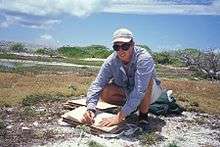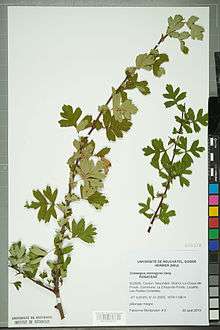Plant press
A plant press is a set of equipment used by botanists to flatten and dry field samples so that they can be easily stored. A professional plant press is made to the standard maximum size for biological specimens to be filed in a particular herbarium. A flower press is a similar device of no standard size that is used to make flat dried flowers for pressed flower craft.


Specimens prepared in a plant press are later glued to archival-quality card stock with their labels, and are filed in a herbarium. Labels are made with archival ink (or pencil) and paper, and attached with archival-quality glue.
Construction

A modern plant press consists of two strong outer boards with straps that can be tightened around them to exert pressure. Between the boards, fresh plant samples are placed, carefully labelled, between layers of paper. Further layers of absorbent paper and corrugated cardboard are usually added to help to dry the samples as quickly as possible, which prevents decay and improves colour retention. Layers of a sponge material can be used in order to prevent squashing parts of the specimens, such as fruit. Older plant presses and some modern flower presses have screws to supply the pressure, which often limits the thickness of the stack of samples that can be put into one press.
History
Luca Ghini (1490—1556) Italian physician and botanist, created the first recorded herbarium, and is considered the first person to have used drying under pressure to prepare a plant collection.[1]
William Withering English botanist, geologist, chemist and physician wrote popular books on British botany, and by describing the screw-down plant press (and the vasculum) he brought it to the attention of amateur naturalists in Britain around 1771.[2]
References
| Wikimedia Commons has media related to Plant presses. |
- Collecting Herbarium Specimens, Botanical Research Institute of Texas
- Jane Mygatt (2001). "A Case for Collecting" (PDF). Iowa Native Plant Society Newsletter. 7 (3): 5–6. Retrieved 30 December 2015.
External links
- Mary Gibby (18 November 2006), "New Voyage for Darwin's Plants", Lothian Life — illustrates use of a plant press.